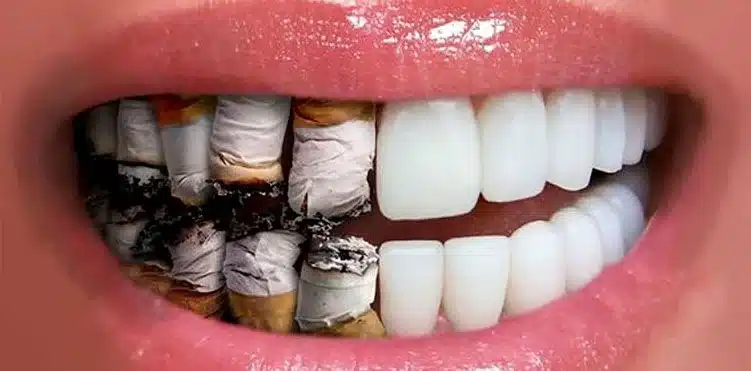Introduction
Smoking is one of the most harmful habits for overall health, and its effects on the mouth are especially severe. Beyond bad breath and stained teeth, smoking damages gums, weakens the immune system, and increases the risk of oral cancer. Understanding how smoking affects oral health and teeth appearance is the first step toward prevention and recovery.
The Impact of Smoking on Oral Health
1. Stained and Discolored Teeth
Nicotine and tar in cigarettes stick to tooth enamel, turning teeth yellow or brown over time. Regular smokers often struggle with stubborn stains that brushing alone cannot remove.
2. Persistent Bad Breath (Halitosis)
Tobacco leaves lingering chemicals in the mouth, dries out saliva, and creates an environment where bacteria thrive. This leads to chronic bad breath that mints or mouthwash can only temporarily mask.
3. Increased Risk of Gum Disease
Smoking reduces blood flow to the gums, making it harder for the body to fight infections. As a result, smokers are two to six times more likely to develop gum disease, which can lead to swollen gums, bleeding, and eventually tooth loss.
4. Slower Healing After Dental Procedures
Because smoking weakens the immune system, wounds in the mouth heal more slowly. This delays recovery after tooth extractions, implants, or gum treatments and increases the risk of complications.
5. Reduced Sense of Taste and Smell
Tobacco dulls taste buds and affects smell receptors, reducing the ability to enjoy food and drinks fully. Many smokers report that flavors seem less sharp or appealing.
6. Higher Risk of Oral Cancer
Long-term smoking is a leading cause of oral cancers, including cancers of the lips, tongue, throat, and gums. Early symptoms like mouth sores, white patches, or lumps often go unnoticed until the disease progresses.
The Effect of Smoking on Teeth Appearance
1. Tooth Stains and Yellowing
Smoking causes stubborn discoloration that professional cleaning or whitening is often required to fix.
2. Tooth Loss
Advanced gum disease from smoking weakens the support structure of teeth, making them loose and prone to falling out.
3. Premature Aging of the Smile
Gum recession, dark stains, and missing teeth make a smoker’s smile appear older than their actual age.
Can Quitting Smoking Improve Oral Health?
Yes! While some damage (like tooth loss) is permanent, quitting smoking allows the mouth to begin healing. Benefits include:
- Reduced risk of gum disease progression
- Fresher breath and better sense of taste
- Improved healing after dental treatments
- Lower chance of oral cancer over time
- Whiter, healthier-looking teeth with proper care
Preventive Measures for Smokers
- Visit a dentist at least twice a year for check-ups and cleaning.
- Practice proper oral hygiene: brushing, flossing, and using mouthwash.
- Drink more water to reduce dry mouth.
- Eat a diet rich in fruits and vegetables to strengthen gums and teeth.
- Seek professional help for quitting smoking (counseling, nicotine replacement, or medications).
Conclusion
Smoking has devastating effects on oral health, from stained teeth and bad breath to gum disease and increased cancer risk. It not only damages the mouth but also affects confidence and overall quality of life. The best step anyone can take for a brighter smile and healthier mouth is to quit smoking. With proper dental care and professional support, many of the negative effects can be reduced, helping restore both oral health and teeth appearance.

